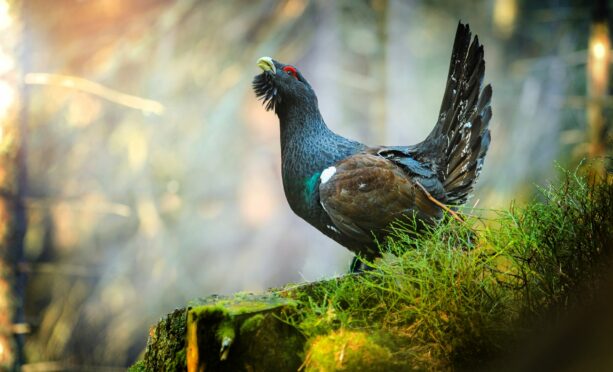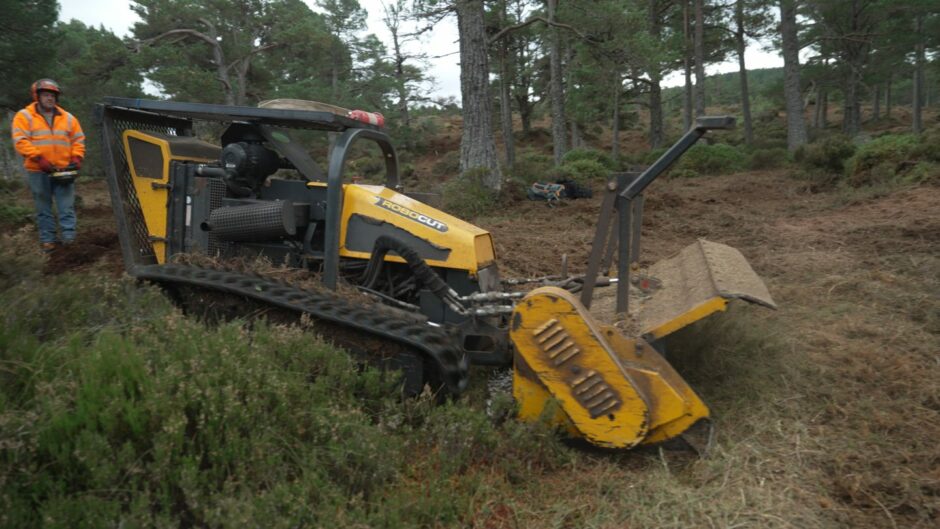
Remote-control mini-tractors have been enlisted to help save the capercaillie, Scotland’s most threatened bird.
A large-scale trial is taking place at the RSPB’s Abernethy Nature Reserve, in the Cairngorms National Park, using the small remote-controlled flail tractors to improve the diversity of habitat for the threatened birds.
The robocutters mulch areas of long vegetation such as dense heather on the forest floor to provide space for other forest plants to move in, improving botanical and invertebrate diversity.
Smaller and more flexible than a conventional tractor, a robocutter can access small spaces and avoid rocks, ant hills and patches of blaeberry, which is an important food plant for capercaillie.
The technology also enables conservationists to leave islands of cover for the birds and their young to retreat and hide from predators.
The work is part of LIFE 100% for Nature, a project funded by the LIFE programme of the European Union, NatureScot, Cairngorms Connect ELP, The Famous Grouse and other funders and supporters.
Uwe Stoneman, senior site manager at RSPB Scotland Abernethy Nature Reserve, said: “The forest is quite a difficult environment to operate in because it’s got trees and humps and bumps, so a bigger machine would find it difficult to access.
“Capercaillie need cover to hide from predators but they also need open spaces, especially when they have their young.
“The chicks are very small and they can’t fly so they have to move around the forest floor. If you’re a small chick, moving around this open area is much easier, but if there is a predator, you have all these islands of tall vegetation that you can withdraw in.”
The trial aims to replicate the disturbance that would have been created in the past by animals like wild cattle and reintroduce diversity that centuries of human intervention has reduced, and to find if robocutters are more effective than other approaches such as grazing.
Areas where robocutters have been employed are being monitored for invertebrates, plants and capercaillie.
Initial results suggest the birds are benefitting from the technology as plants like blaeberry and cowberry begin to emerge in place of dense heather that dominated previously.
The cut areas have also allowed pine seedlings to germinate, while smaller creatures in the forest such as wood ants and the very rare narrow-headed ant have been able to colonise.
Stoneman added: “Capercaillie not only rely on plants like blaeberry for an invertebrate food source, but also like a mix of dense cover and open spaces.
“Thicker vegetation gives chicks somewhere to hide from predators. Open areas are easier for the tiny chicks to move in and allow birds to dry out after wet weather.
“We’ve seen capercaillie droppings and dust baths, where they clean themselves with sandy soil, within the cut areas so this is a promising sign that they are using these sections of forest already.”
The capercaillie is the largest member of the game bird family. The bird, whose Gaelic name means “Horse of the woods”, was reintroduced to Scotland in 1837 after becoming extinct the previous century.
More than 80% of Scotland’s capercaillie live and breed in pine woods in the Cairngorms National Park. However, a steep decline in recent years has seen the iconic bird included on the Red List of species of highest conservation concern.
In 2017, RSPB Scotland and Scottish Natural Heritage compiled a study that estimated that there were just 1,114 capercaillies left. It is feared a new year census due to be completed this year will reveal further declines.
The robocutter trial at RSPB Abernethy is one of a range of schemes designed to help reverse this trend by providing safe breeding grounds, predator control and limiting human disturbance.

Enjoy the convenience of having The Sunday Post delivered as a digital ePaper straight to your smartphone, tablet or computer.
Subscribe for only £5.49 a month and enjoy all the benefits of the printed paper as a digital replica.
Subscribe © SYSTEM
© SYSTEM